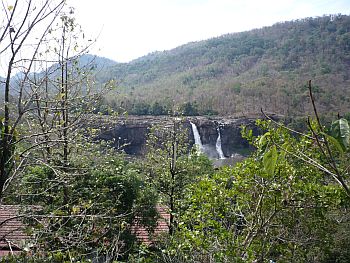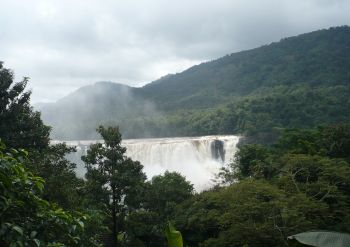The flow at the Athirappilly falls near Thrissur in Kerala has been curtailed to cap the tourist influx. Registering a complaint with the District Collector, the tourists and local people alleged that the Kerala State Electricity Board (KSEB) had done this to add a new justification to the proposed seventh dam on the Chalakudy river.
That this has been done from the upstream Poringalkuthu reservoir came to the notice of activists on 25 March. The waterfalls depends on release from the Poringalkuthu reservoir upstream.

![]() Reduced flow at the Athirappilly falls near Thrissur, from February this year. See second picture
below for the falls view in full bloom during the monsoons. Pic: River Research Centre.
Reduced flow at the Athirappilly falls near Thrissur, from February this year. See second picture
below for the falls view in full bloom during the monsoons. Pic: River Research Centre.
The picturesque water falls is a couple of hours drive from the concrete jungle of Kochi. This is the last stretch of the river that flows freely before it merges into the Arabian Sea. Most of the upstream having been already dammed, a new dam will sound the death knell for the river.
Proposed dam will reduce Athirappilly falls to trickle
KSEB is preparing to move heavy earth machinery for building what will be the seventh dam across the Chalakudy, the 144 kilometers long river in the ecologically fragile Western Ghats. However, local people are fighting a decisive battle to save the waterfalls. Had the courts not intervened in the past, Athirappilly would have long met the same fate as the Jog Falls in Karnataka.
Ammini, a mother of three, is leading the ongoing campaign against the proposed dam and contends that odds are stacked in their favour. Some million tourists are attracted to the site each year, sustaining livelihoods of several hundred families engaged in providing services. Her small kiosk has been the favourite of most visiting film crews but she is piqued at their non-indulgence as the picturesque site waits for its doom.
The proposed dam will cap about 86 per cent of all water flowing in the river, reducing the falls at Athirappilly to a trickle. But KSEB is unmoved. Not without reason has it revised the detailed project report (DPR) four times since 1989 during which it faced two court strictures, first of which suspended the environmental clearance given in 1998 while the second quashed similar clearance given in 2005. Environmental clearance is given by the Ministry of Environment and Forests, New Delhi.
It is alleged that manipulating data has remained KSEB's quest to secure fresh clearance every time it hits a judicial roadblock. The latest clearance obtained on 18 July 2007. Five members from the River Valley Committee of MoEF had visited the project site and held discussions with the people and also held a public consultation in April 2007. Ironically, the report did not have a word on 'environment'.
On the other hand, it is worth mentioning that two mandatory public hearing held following the High Court's directives, had both rejected the project. The first was held as on 6 Feb 2002 at Thrissur Town Hall, which around 500 people attended. The second was held on 25 June 2006 at Chalakudy, the dam site. The venue was shifted from Thrissur to Chalakudy due to complaints by the petitioners. Around 1500 people took part.

![]() View during the monsoons. Pic: River Research Centre.
View during the monsoons. Pic: River Research Centre.
Despite all this, there has been no let-up in the efforts by the board to get the project implemented. According to a report by the River Research Centre at Thrissur the proposed 163 MW hydroelectric project will be one of the least efficient, operating at a plant load factor of 16 per cent. And at a projected investment of Rs.700 crores, which is five times its original estimate, the power generated will be grossly expensive.
Dubious justifications
The project appears to be based on dubious justifications. Else, how could a project that will scuttle the downstream Thumpurmuzhi irrigation project which commands 40,000 acres in Trissur and Ernakulum districts be ignored? And how could its direct impact on the tourism revenue and local livelihoods get sidestepped?
There are threatened species too. Four species of rare hornbills, a rich diversity of 104 different fish and some 2.1 elephants traversing each kilometre in the valley do not seem to have impacted KSEB's single-minded pursuit.
Refer the number of families to be displaced and the discourse takes a different turn. Will it matter if 78 families of the Kadar tribe, the primitive hunter gatherers endemic to the river valley, get relocated to a new site? Relocation and rehabilitation is more of a norm than exception in the case of big projects and why should Athirappilly be any different?
Yet, these are the tools that have repeatedly been deployed to contest big projects. That the proposed project will dry the remaining stretch of the river and that it will be the most dammed river of its size should the proposed project get commissioned are consequences that one may has to live with. "But this is an avoidable blunder," argues S P Ravi of RRC, "mere seven percent reduction in the prevailing transmission losses from existing power projects can contribute as such as 1000 MW of additional power."
The reasons for dropping the project have multiplied ever since. Land use change caused by deforestation and submergence has been acknowledged by the Intergovernmental Panel on Climate Change (IPCC) as one of the critical factors in affecting climate change. With the Council on Climate Change convened by the Prime Minister seized on matter like these, no two thoughts should be spared on summarily rejecting the project at Athirappilly.

